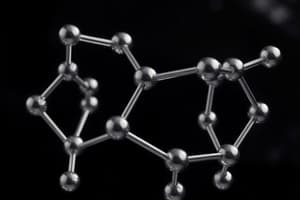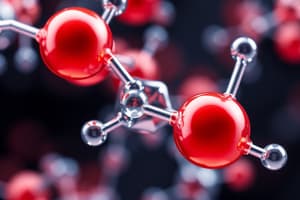Podcast
Questions and Answers
What is the pH at point X, where the buffering capacity ends?
What is the pH at point X, where the buffering capacity ends?
- 3.8 (correct)
- 4.8
- 5.8
- 2.8
What is the value of pKa in this reaction?
What is the value of pKa in this reaction?
- 2.8
- 5.8
- 4.8 (correct)
- 3.8
What equation can be used to solve for [A-]/[HA]?
What equation can be used to solve for [A-]/[HA]?
- Buffer equation
- pH equation
- pKa equation
- Henderson-Hasselbalch equation (correct)
What is the significance of point X in a buffering system?
What is the significance of point X in a buffering system?
What is the relationship between pH and pKa at point X?
What is the relationship between pH and pKa at point X?
What happens to each proton in a lactate buffer?
What happens to each proton in a lactate buffer?
What is the purpose of a lactate buffer?
What is the purpose of a lactate buffer?
If a lactate buffer contains 75% lactic acid and 25% lactate, what can be inferred about the pH?
If a lactate buffer contains 75% lactic acid and 25% lactate, what can be inferred about the pH?
What is the effect of increasing the proportion of lactate in a lactate buffer?
What is the effect of increasing the proportion of lactate in a lactate buffer?
What is the significance of knowing the pH of a lactate buffer?
What is the significance of knowing the pH of a lactate buffer?
What is the relationship between the concentration of HCl and NaOH in terms of their moles produced?
What is the relationship between the concentration of HCl and NaOH in terms of their moles produced?
When titrating 1M HNO3 with Ba(OH)2, how many moles of OH- are produced per mole of Ba(OH)2?
When titrating 1M HNO3 with Ba(OH)2, how many moles of OH- are produced per mole of Ba(OH)2?
Using the formula N x M1 x Vol1 = n x M2 x Vol2, what would M2 be if N = 1, M1 = 0.12, Vol1 = 22.4, and Vol2 = 12?
Using the formula N x M1 x Vol1 = n x M2 x Vol2, what would M2 be if N = 1, M1 = 0.12, Vol1 = 22.4, and Vol2 = 12?
How does the number of equivalents of acid relate to the number of equivalents of base in a neutralization reaction?
How does the number of equivalents of acid relate to the number of equivalents of base in a neutralization reaction?
In a neutralization reaction involving HCl and NaOH, how many moles of water are produced from the reaction of 1 mole of HCl with 1 mole of NaOH?
In a neutralization reaction involving HCl and NaOH, how many moles of water are produced from the reaction of 1 mole of HCl with 1 mole of NaOH?
What phenomenon occurs due to the rotation of carbon atoms around a single covalent bond?
What phenomenon occurs due to the rotation of carbon atoms around a single covalent bond?
How is the electronegativity of carbon described in relation to other atoms?
How is the electronegativity of carbon described in relation to other atoms?
Which statement reflects a property of carbon in a covalent bond?
Which statement reflects a property of carbon in a covalent bond?
What is the primary outcome of the rotation of carbon atoms within a molecule?
What is the primary outcome of the rotation of carbon atoms within a molecule?
What is NOT true about the properties of carbon?
What is NOT true about the properties of carbon?
What defines a solution as a buffer?
What defines a solution as a buffer?
How are pKa values of weak acids typically determined?
How are pKa values of weak acids typically determined?
Which statement about buffers is correct?
Which statement about buffers is correct?
In the context of acid-base chemistry, what does the term 'titration' refer to?
In the context of acid-base chemistry, what does the term 'titration' refer to?
What implication does a weak acid's pKa value have?
What implication does a weak acid's pKa value have?
Flashcards are hidden until you start studying
Study Notes
Carbon Backbone and Properties
- Carbon atoms in a backbone can rotate around a single covalent bond, resulting in molecules with different shapes.
- Electronegativity of carbon is between that of other atoms.
Acid-Base Reactions
- 1 mole of HCl produces 1 mole of H+, which is neutralized by 1 mole of NaOH, producing 1 mole of OH-.
- The equation for acid-base reactions is: N x M1 x Vol1 = n x M2 x Vol2.
Titration and Buffer Solutions
- A solution that can resist changes in pH is called a buffer.
- Titration is used to determine the pKa values of weak acids.
- At the end of the buffering capacity, pH = pKa - 1.
Henderson-Hasselbalch Equation
- The equation is used to solve for [A-]/[HA] in a buffer solution.
- Each proton dissociates at a certain pH.
Example Problem
- A lactate buffer contains 75% lactic acid and 25% lactate; the pH can be calculated using the Henderson-Hasselbalch equation.
Studying That Suits You
Use AI to generate personalized quizzes and flashcards to suit your learning preferences.




